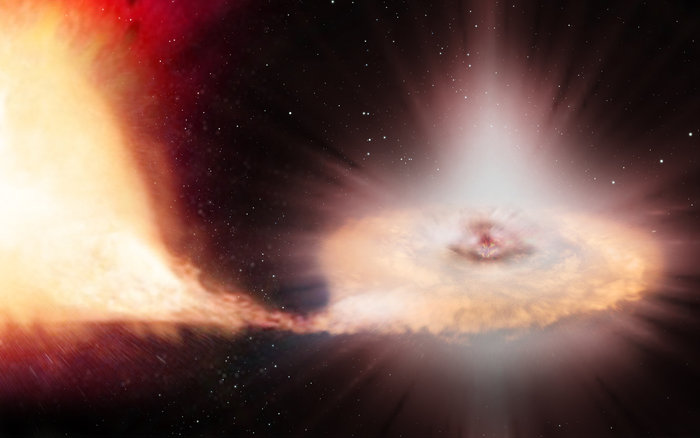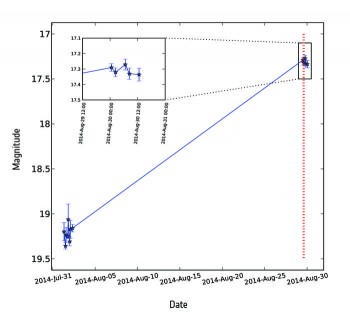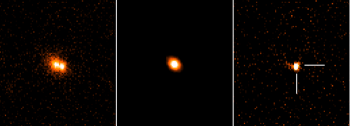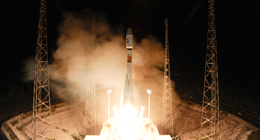While scanning the sky to measure the positions and movements of stars in our Galaxy, Gaia has discovered its first stellar explosion in another galaxy far, far away.
 This powerful event, now named Gaia14aaa, took place in a distant galaxy some 500 million light-years away, and was revealed via a sudden rise in the galaxy’s brightness between two Gaia observations separated by one month.
This powerful event, now named Gaia14aaa, took place in a distant galaxy some 500 million light-years away, and was revealed via a sudden rise in the galaxy’s brightness between two Gaia observations separated by one month.
Gaia, which began its scientific work on 25 July, repeatedly scans the entire sky, so that each of the roughly one billion stars in the final catalogue will be examined an average of 70 times over the next five years.
“This kind of repeated survey comes in handy for studying the changeable nature of the sky,” comments Simon Hodgkin from the Institute of Astronomy in Cambridge, UK.
Many astronomical sources are variable: some exhibit a regular pattern, with a periodically rising and declining brightness, while others may undergo sudden and dramatic changes.
“As Gaia goes back to each patch of the sky over and over, we have a chance to spot thousands of ‘guest stars’ on the celestial tapestry,” notes Dr Hodgkin. “These transient sources can be signposts to some of the most powerful phenomena in the Universe, like this supernova.”
Dr Hodgkin is part of Gaia’s Science Alert Team, which includes astronomers from the Universities of Cambridge, UK, and Warsaw, Poland, who are combing through the scans in search of unexpected changes.
It did not take long until they found the first ‘anomaly’ in the form of a sudden spike in the light coming from a distant galaxy, detected on 30 August. The same galaxy appeared much dimmer when Gaia first looked at it just a month before.
“We immediately thought it might be a supernova, but needed more clues to back up our claim,” explains Łukasz Wyrzykowski from the Warsaw University Astronomical Observatory, Poland.
Other powerful cosmic events may resemble a supernova in a distant galaxy, such as outbursts caused by the mass-devouring supermassive black hole at the galaxy centre.
However, in Gaia14aaa, the position of the bright spot of light was slightly offset from the galaxy’s core, suggesting that it was unlikely to be related to a central black hole.
So, the astronomers looked for more information in the light of this new source. Besides recording the position and brightness of stars and galaxies, Gaia also splits their light to create a spectrum. In fact, Gaia uses two prisms spanning red and blue wavelength regions to produce a low-resolution spectrum that allows astronomers to seek signatures of the various chemical elements present in the source of that light.
Read the full story on Gaia’s first supernova discovery on the ESA Portal.




Discussion: 3 comments
I’m curious if, after enough scans, we can come to a conclusion as to how often we might expect close “calls” of supernovae or gamma ray bursts etc. that could threaten earth, as well as a statistical timeline as to which extinction events might have coincided with similar disruptions in the past.
I Think this might be a quasar Twin battle for which is the
more powerfull in spacial terms of the two and that the Winner will conquer space-dissonance to have it’s own wobble worked out as basic galactic tidal forces in action. The basic pull of Galaxies would be tidal and very slow.
hi, i read some where that there isa super nova for every 100 milion stars ,, or 1 every 100 milion years..